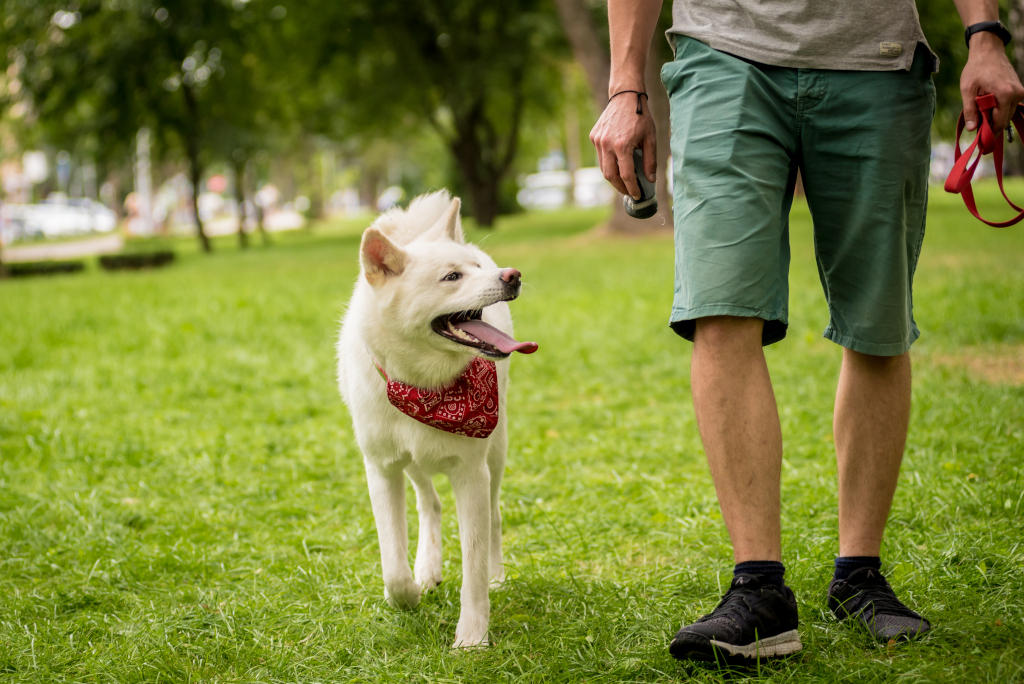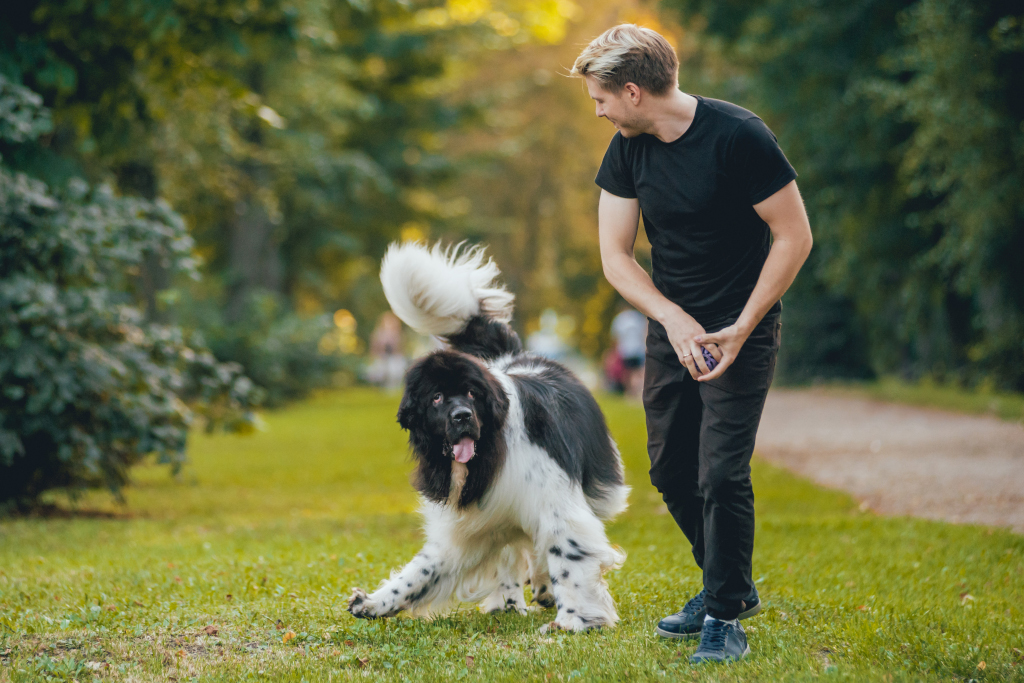
Is your dog a master at tugging you in all directions during walks?
Are you tired of being pulled and dragged down the street and seeking a way to teach your pup to stop pulling?
If so, you are in the right place!
Loose-leash walking is an essential skill that will provide you and your dog with more enjoyable, stress-free walks.
Here are five different techniques you can use to teach your pooch how to walk nicely on a leash, and you’ll be on your way to getting your furry friend to walk like a model canine citizen in no time!
#1. The Silky Leash
The Silky Leash Technique is a simple and effective way of teaching your pup proper leash etiquette. With this method, your dog will return to your side when there’s a slight tension on the leash.
How does this technique help?
Dogs will instinctively resist pressure and pull back against you in the opposite direction when you pull, also referred to as the opposition reflex. This technique teaches your dog to give in or move with pressure instead of against it. Meaning? No more pulling! Because your dog’s conditioned response to leash pressure is to move toward you!
Here’s how to do it:
- Step 1: Find a quiet room, grab some treats, and use a clicker or words like “yes” or “good” to mark the desired behavior.
- Step 2: Attach the leash to your dog’s collar or harness.
- Step 3: Gently apply a slight pressure for a second and release it immediately, then feed your dog a treat. This is to create a positive association with leash pressure. Repeat this multiple times until your dog is comfortable with the sensation.
- Step 4: Pull gently on the leash and use the “come” cue to encourage your pup to come to your side. Alternatively, you can entice them with a treat. The second they move toward you, and the leash becomes loose, praise them and give them a treat. Repeat this in an indoor space until your canine can respond to leash pressure quickly before taking them outside for further practice.
You May Also Like: The Importance of Leash Pressure
#2. Red Light, Green Light
You probably have heard of this “Red Light, Green Light” game. The idea behind this leash-training method is that when your dog pulls on the leash, it is like them stepping on a red light and must come to a complete stop. Then, when the pressure on the leash is released, you will give them the “green light” to keep moving forward.
How does this technique help?
One of the reasons dogs pull is because it’s rewarding. Every time they pull, they get to move forward and, therefore, a step closer to the object of their desire (a squirrel, another dog, etc.). With this method, you teach your four-legged friend that pulling does not result in what they want and that walking on a loose leash is the only way to get closer to their desired destination, ultimately eliminating the incentive to pull in the first place.
Here’s how to do it:
- Step 1: Leash your dog and start walking.
- Step 2: When your pooch pulls, and the lead becomes taut, stop walking immediately and stand completely still.
- Step 3: Wait for your pup to turn back to you to release the leash pressure.
- Step 4: As soon as they do and the leash goes slack, continue walking. If they don’t, simply make a kissing sound, pat your leg, or call their name to encourage them to move back toward you.
- Step 5: Repeat this process (stop moving when the leash tightens and continue walking when the leash is loose) until your dog gets the idea and can walk without tension on the lead.

#3. 1-2-3 Walking Pattern
This 1,2,3 pattern game is a set of exercises that provides an easy way for your dog to become accustomed to the changes in their environment. Through this method, your canine will learn to stay focused on you and remain calm when faced with potential triggers that may cause them to pull, such as a passing dog or a squirrel in the distance.
How does this pattern game help?
It’s no secret that dogs will pull when they are overly excited or distracted by something. By teaching your dog this game, you’ll be able to use it to break their focus on exciting things around them and get them to pay attention to you.
Here’s how to do it:
- Step 1: Find a quiet spot, have your pup on a leash, and say “three,” then give them a treat. This is to pair the word “three” with a treat. Keep practicing this until your dog understands that “three” means a treat is coming.
- Step 2: You can now add “two” to the game. So instead of just saying “three,” you will say “two, three” and give them a treat the moment you say the number “three.”
- Step 3: You’ll now add in “one” and count out “one, two, three.” Like before, you want to treat your dog as soon as you say the word “three.” Repeat this until your pooch can reliably respond to “one, two, three” by looking at you and expecting a treat.
- Step 4: After they’ve learned it, you can start walking around while saying “one, two, three,” then giving them treats each time you count to “three.”
- Step 5: Practice this outside and gradually add in distractions to further prove that your dog will ignore any exciting things that come their way and stay focused on you as you start counting.
#4. The Reverse Direction
This technique is similar to the “Red Light, Green Light” method. However, instead of stopping and encouraging your dog to walk back towards you to release the leash pressure, you will turn around and walk back in the opposite direction. This will put your canine behind you, and they’ll have no choice but to follow you.
How does this technique help?
By turning around and walking back the other way, you break your dog’s focus on whatever is distracting them and redirect their attention back to you. This teaches your pup that when walking with you, they need to pay attention to you, stay focused, and follow your pace.
Here’s how to do it:
- Step 1: Get your dog leashed up and start walking.
- Step 2: As soon as they rush ahead and you anticipate that they’re about to hit the end of the leash, turn around 180 degrees and head in the opposite direction. Note that no jerking or correction is required. And as you turn around, you’ll want to lower the hand holding the leash to your dog’s eye level and gently pull them toward you to guide them into position. You can also use cues like “this way” when you turn to encourage them to follow you.
- Step 3: Start walking in the opposite direction, and once your fido catches up to you and is walking right by your side, praise or give them a treat.
- Step 4: Repeat this technique when your dog tries to pull ahead until they learn to walk closer to you and be more attentive.
#5. Reward Check-Ins
The reward check-in technique is basically a method to get your dog to look at you and check in with you while walking. This will help you gain your fido’s focus and get them to pay attention to you while out on walks, and as a result, they are less likely to get distracted by the things around them that may cause them to pull.
How does this method help?
Well. Your dog can’t give you eye contact if they lag behind. Or if they are ahead of you, they’ll have to stop and turn around to look at you. Either way, this will help reposition them to your side and get them to walk right next to you on a loose lead.
Here’s how to do it:
- Step 1: Put a treat on your dog’s nose, ask them to look at you, then bring the treat up to your eyes. And the moment they look you in the eyes, give them the treat. As with any dog training, ensure to start indoors or in a low-distraction environment.
- Step 2: Once your dog understands what “look at me” or “watch me” means, you can hold the treat a little bit longer at your face before rewarding them to build up the duration of their eye contact.
- Step 3: Move on to practice this while you’re out walking. If your dog doesn’t give you eye contact when you ask them to check in with you while outside, that means you’re progressing too quickly. Just go back a step and practice in places with fewer distractions until they get better at it.

